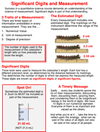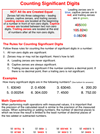Notes:
The Classification of Matter Concept Builder is an adjustable-size file that displays nicely on smart phones, on tablets such as the iPad, on Chromebooks, and on laptops and desktops. The size of the Concept Builder can be scaled to fit the device that it is displayed on. The compatibility with smart phones, iPads, other tablets, and Chromebooks make it a perfect tool for use in a 1:1 classroom.
Teaching Ideas and Suggestions:
We're going to be honest: we do Physics. That's why this is called The Physics Classroom website. And when we do the Teacher's Notes section for our Concept Builders, we typically have a lot to say ... and a lot of resources to point you to. We're not claiming to be ignorant of chemistry; we just don't have a lot of resources here at The Physics Classroom to point you to. And so this page is going to be a lot shorter than our usual page that accompanies our Physics Concept Builders. That's our honest confession.
Identifying a substance can be difficult. But when students have a scheme for approaching the question of what is in a sample of matter, they proceed with more confidence. During the early part of most chemistry courses, this question of identifying what is in a sample of matter surfaces as the topic of classification of matter is discussed. A sample of matter can be made of purely one substance or can be a collection of substances mixed together. The substances - whether they be pure or mixtures - are either elements or compounds. If there are two or more elements and/or compounds in a mixture, they can be distributed uniformly throughout the mixture (homogeneous) or can be separated into distinct parts, regions, or phases (heterogeneous). The purpose of this Concept Builder is to target and improve student understanding of the classification of matter.
Each question in the Concept Builder has a Help Me! button which links to a page that discusses the question and provides background information about matter classification. The guts of these Help pages is two graphics that explain the logic of dissecting what could be in a sample of matter:


There are four activities in the Concept Builder. Those four activities are differentiated as follows:
- Class Matters: Question Group 1 ... Identify the definitions or distinguishing characeristics of an element, a compound, a homogeneous mixture, and a heterogeneous mixture.
- Photo ID: Question Groups 2-5 ... Based on a photo of a sample of matter, classify the sample as a pure substance, a homogeneous mixture, or a heterogeneous mixture.
- Formula for Class: Question Groups 6-7 ... Given a formula for a sample of matter, identify the sample as either a pure element, a pure compound, a homogeneous mixture, or a heterogeneous mixture.
- Particle Diagram: Question Groups 8-11 ... Given a particle diagram of a sample of matter, identify the best description of the sample using terms such as element, compound, pure substance, and mixture.
The questions from each group are shown on
a separate page. Teachers are encouraged to view the questions in order to judge which activities make the best fit with their curriculum. Like all our Concept Builders, this Concept Builder utilizes a variety of strategies to make each student's individual experience slightly different. The ordering of questions is random. The Question number assigned to each question is scrambled. For instance, two side-by-side students will not have the same question for question number three. And questions are organized into "groups" with questions within the same group being very similar (for instance, they have the same type of information as "givens") but not identical.
In order to complete an activity, a student must correctly analyze each question of that activity. If a student's analysis is incorrect, then the student will have to correctly analyze the same or very similar question twice in order to successfully complete the activity. This approach provides the student extra practice on questions for which they exhibited difficulty. As a student progresses through an activity, a system of stars and other indicators are used to indicate progress on the activity. A star is an indicator of correctly analyzing the question. Once a star is earned, that question is removed from the que of questions to be analyzed. Each situation is color-coded with either a yellow or a red box. A red box indicates that the student has incorrectly analyzed the question and will have to correctly analyze it twice before earning a star. A yellow box is an indicator that the question must be correctly analyzed one time in order to earn a star. Once every question of an activity has been analyzed, the student earns a Trophy which is displayed on the Main Menu. This system of stars and trophies allows a teacher to easily check-off student progress or offer credit for completing assigned activities.
The most valuable (and most overlooked) aspect of this Concept Builder is the
Help Me! feature. Each question group is accompanied by a Help page that discusses the specifics of the question. This Help feature transforms the activity from a question-answering activity into a concept-building activity. The student who takes the time to use the Help pages can be transformed from a guesser to a learner and from an unsure student to a confident student. The "meat and potatoes" of the Help pages are in the sections titled "How to Think About This Situation:" Students need to be encouraged by teachers to use the Help Me! button and to read this section of the page. A student that takes time to reflect upon how they are answering the question and how an expert would think about the situation can transform their naivete into expertise.